Operator’s Guide
FACSIMILE FX100
Please read this guide before you use this equipment.
Thank You for Choosing Samsung
Thank you for choosing Samsung! Your new fax machine represents the very latest in fax
machine technology. The FX100 is a full-featured, high-performance machine built to strict
quality standards set by Samsung-the highest in the industry. We’re proud to offer you a
product that will provide convenient, dependable service for years to come.
Important Safety Information
Always be careful when using the machine. To reduce the risk of fire, electrical shock,
and other injuries, keep these safety considerations in mind when installing, using, and
maintaining your machine:
Stability: Place the machine on a secure, stable surface. The machine can cause serious
damage if it falls.
Power Supply: Provide the correct power to the machine, as listed on its back. If you
are not sure of the type of power that is supplied to your home or office, call your
electric company.
Grounding: It must be plugged into a grounded outlet for your safety. If you can’t
insert the plug into your wall outlet easily, the outlet should be inspected by a qualified
electrician.
Overload: Don’t plug too many electrical devices into a wall outlet or extension cord.
An overloaded outlet is a fire and electrical shock hazard.
Cleaning: Before cleaning the machine, unplug it from both the power outlet and the
telephone jack. Clean exposed parts with a soft cloth slightly dampened with water.
Thunderstorms: Unplug electrical appliances during thunderstorms. Avoid using any
telephone (except a cordless model) during a thunderstorm, since there’s a small chance
you could get an electrical shock from lightning.
Gas Leaks: Never use a telephone close to a gas leak. If you think gas is leaking, call the
gas company immediately, but use a telephone far away from the leak area. A small
electrical spark in the telephone could cause a fire.
PREFACE
FCC Information
The following information is only applicable to facsimile machines installed in the United
States of America.
Label Identification
This equipment complies with Part 68 of the FCC rules. On the rear of this equipment is a
label that contains, among other information, the FCC Registration Number and Ringer
Equivalence Number (REN) for this equipment. You may need to provide this
information to your telephone company.
Type of Service
This equipment is designed to be used on standard device telephone lines. Connection to
a telephone company-provided coin service (central office implemented systems) is
prohibited. Connection to party-line service is subject to state tariffs.
Telephone Company Procedure
The goal of the telephone company is to provide you with the best service possible. In
order to do this, it may occasionally be necessary for it to make changes in this equipment,
operation, or procedures. If these changes affect your service or the operation of the
equipment, the telephone company will give you notice in writing, to allow you to make
any changes necessary to maintain uninterrupted service.
If you have any questions about your telephone line, such as how many pieces of
equipment you can connect to it, the telephone company will provide this information
upon request.
In certain circumstances, it may be necessary for the telephone company to request
information from you concerning the equipment you have connected to your telephone
line. Upon request of the telephone company, provide the FCC Registration Number and
the Ringer Equivalence Number (REN) of the equipment that is connected to your line;
both of these items are listed on the equipment label. The sum of all of the RENs on your
telephone line should be less than five in order to ensure proper service from the
telephone company. In some cases, a sum of five may not be usable on a given line.
About Interference
This equipment has been tested and found to comply with the limits for a Class B digital
device, pursuant to Part 15 of the FCC Rules. These limits are designed to provide
reasonable protection against harmful interference in a residential installation. This
equipment generates, uses, and can radiate radio frequency energy and, if not installed
and used in accordance with the instructions, may cause harmful interference to radio
communications. However, there is no guarantee that interference will not occur in a
particular installation. If this equipment does cause harmful interference to radio or
PREFACE i
PREFACE
television reception, which can be determined by turning the equipment off and on, the
user is encouraged to try to correct the interference by one or more of the following
measures:
Reorient or relocate the receiving antenna.
Increase the separation between the equipment and the receiver.
Connect the equipment into an outlet on a circuit different from that to which the
receiver is connected.
Consult the dealer or an experienced radio/TV technician for help.
The Telephone Consumer Protection Act of 1991 makes it unlawful for any person to use a
computer or other electronic device to send any message via a telephone fax machine
unless such message clearly contains in a margin at the top or bottom of each transmitted
page or on the first page of the transmission, the date and time it is sent and an
identification of the business or other entity, or other individual sending the message and
the telephone number of the sending machine or such business, other entity, or
individual. In order to program this information into your fax machine, you should
complete the steps on page 2.7.
If a Problem Arises
If any of your telephone equipment is not operating properly, you should immediately
remove it from your telephone line, as it may cause harm to the telephone network. If the
telephone company notes a problem, it may temporarily discontinue service. When
practical, the telephone company will notify you in advance of the disconnection. If
advance notice is not feasible, you will be notified as soon as possible. When you are
notified, you will be given the opportunity to correct the problem and informed of your
right to file a complaint with the FCC.
Hearing Aid compatible
The telephone handset attached to this equipment is hearing aid compatible.
Lightning
Your unit has built-in protection circuits, which meet or exceed FCC requirements, to
reduce the risk of damage from surges in telephone line currents. However, lightning
striking near or on these lines can cause an excessive surge of voltage that can damage the
phone.
Lightning damage is uncommon. However, if you are concerned about it or live in an area
with frequent and/or severe electrical storms, we suggest that you unplug your electronic
equipment during the storms.
ii PREFACE
PREFACE
IC Information
The following information is applicable only to facsimile machines installed in Canada.
Notices
The Industry Canada (IC) label identifies certified equipment. This certification means
that the equipment meets certain telecommunications network protective, operational,
and safety requirements. The Department does not guarantee the equipment will operate
to the user’s satisfaction.
Before installing this equipment, user should ensure that it is permissible to be connected
to the facilities of the local telecommunications company. The equipment must also be
installed using an acceptable method of connection. In some cases, the company’s inside
wiring associated with a single line individual service may be extended by means of a
certified connector assembly (telephone extension cord). The customer should be aware
that compliance with the above conditions may not prevent degradation of service in
some situations.
Repairs to certified equipment should be made by an authorized Canadian maintenance
facility designated by the supplier. Any repairs or alterations made by the user to this
equipment or equipment malfunctions may give the telecommunications company cause
to request the user to disconnect the equipment.
Users should ensure for their own protection that the electrical ground connections of the
power utility, telephone lines, and internal metallic water pipe system, if present, are
connected together. This precaution may be particularly important in rural areas.
Caution
Users should not attempt to make such connections themselves, but should contact the
appropriate electric inspection authority, or electrician, as appropriate.
The Load Number (LN) assigned to each terminal device denotes the percentage of the
total load to be connected to a telephone loop which is used by the device, to prevent
overloading. The termination on a loop may consist of any combination of devices subject
only to the requirement that the total of the load numbers of all devices does not exceed
100. The Load Number of this unit is #6.
Class B
This Digital Apparatus does not exceed the Class B limits for Radio Frequency noise from
Digital Apparatus set out in the Radio Interference Regulations of the Industry Canada.
PREFACE iii
PREFACE
Renseignements du Industrie Canada
Les renseignements suivants ne s’appliquent qu’aux télécopieurs installés au Canada.
Avis
L’étipuette du Industrie Canada (IC) est une marque d’identification d’appareil certifié.
Cette certification signifie que l’appareil répond à certains critères de sécurité et
d’utilisation. Cependant, le Ministère ne peut pas garantir que l’appareil rencontrera les
exigences de son utilisateur.
Avant de faire l’installation de l’appareil, l’utilisateur devrait s’assurer qu’il paurra
brancher son appareil en utilisant les services généralement offerts par la compagnie
téléphoneque de sa region. If faut s’assurer de brancher convenablement l’appareil. Dans
certains cas, le système interne de communication d’une compagnie possède aussi une
ligne individuelle qu’il vous sera possible d’utiliser avec un dipositif d’assemblage certifié
(rallonge de téléphone). L’utilisateur devrait se renseigner afin de faire une bonne
utilisation de son appareil et de ne pas nuire au système interne de communication de la
compagnie.
Toute réparation d’un appareil certifié devrait être effechée dans un centre d’entretien
approuvé par le fournisseru. Toute réparation ou modification apportée par l’utilisateur à
son appareil ou tout problème de fonctionnement purrait forcer votre compagnie
téléphonique àdébrancher votre appareil.
L’utilisateur devrait s’assurer que les raccordements de mise à la terre de l’alimentation,
des lignes téléphoniques et du système de tuyauterie hydraulique, si présent, soient tous
reliés ensembles. Cette mesure de sécurité est important surtout en milieu rural.
Misc en gard
L’utilisateur ne devrait pas essayer de faire de tels raccordements seul, il devrait faire
appel à du personnel qualifié ou à un électricien selon le cas.
Le numéro de raccordement (LN) se rapporte à chaque appareil et détermine le nombre
maximum de raccordements afin d’éviter une surcharge. La boucle peut comprendre
plusieurs choix différents tant et aussi longtemps que le total des numéros de
raccordement noe dépasse pas la somme de 100. Le numéro de raccordement de votre
appareil est: #6.
Classe B
Cet appareil n’excede pas les limites de la classe B pur les émissions de parasites radio à
partir d’un appareil numérique établies par le règlement sur les parasites radio du
Industrie Canada.
iv PREFACE
CONTENTS
Chapter 1: Your New Machine
Check Parts 1.1
Familiarizing Yourself with Your New Machine 1.2
Front 1.2
Rear 1.3
Control Panel 1.4
Chapter 2: Installation and Setup
Choosing a Location 2.1
Making the Connections 2.1
Installing Paper 2.2
Making a Copy 2.3
Setting up the Fax 2.5
Adjusting Ringer Volume 2.5
Setting Date and Time 2.5
Setting the Terminal ID (Your Name and Number) 2.7
Using the Keypad to Enter Letters 2.9
Keypad Character Assignments 2.9
Checking Dial Type 2.10
Chapter 3: The Fax Machine
Sending a Fax 3.1
Preparing a Document 3.1
Setting Resolution and Contrast 3.2
Loading a Document 3.3
Dialing a Number 3.3
Confirming the Transmission 3.5
Canceling Transmission 3.5
Receiving a Fax 3.6
Reception Modes 3.6
Receiving in TEL Mode 3.6
Receiving in FAX Mode 3.7
Receiving in TAD Mode 3.8
Receiving in AUTO Mode 3.8
Using an Extension Telephone 3.9
Canceling Reception 3.9
Using Voice Request 3.10
Sending a Voice Request 3.10
Answering a Voice Request 3.11
Using Polling 3.11
1 CONTENTS
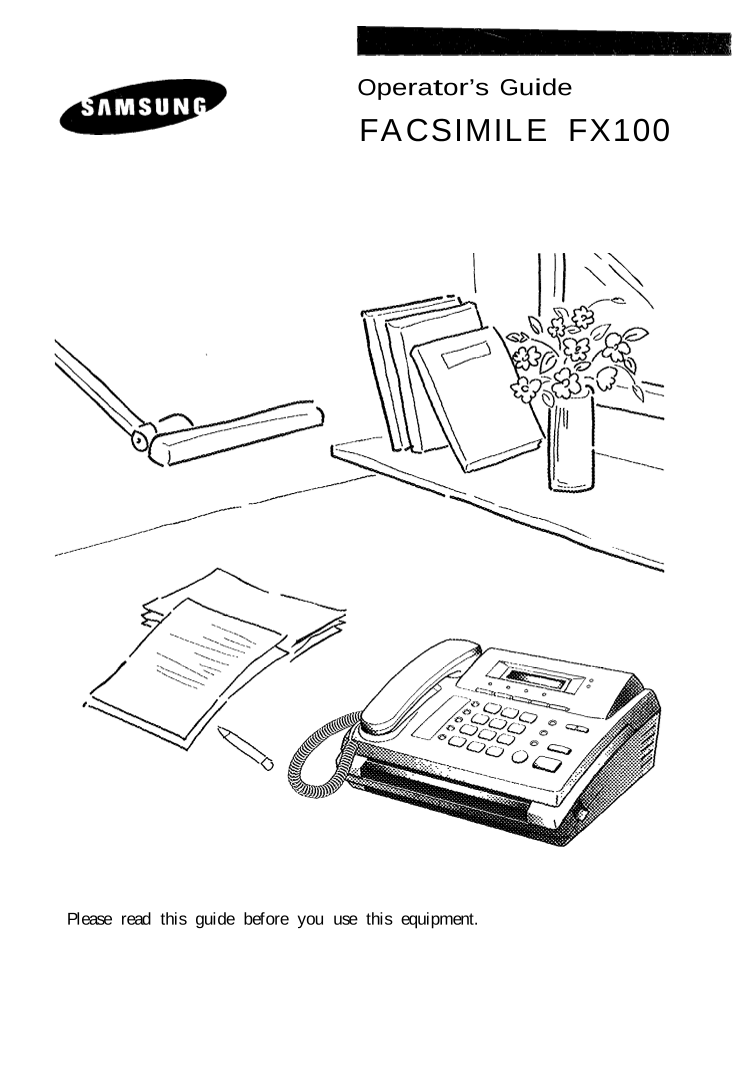

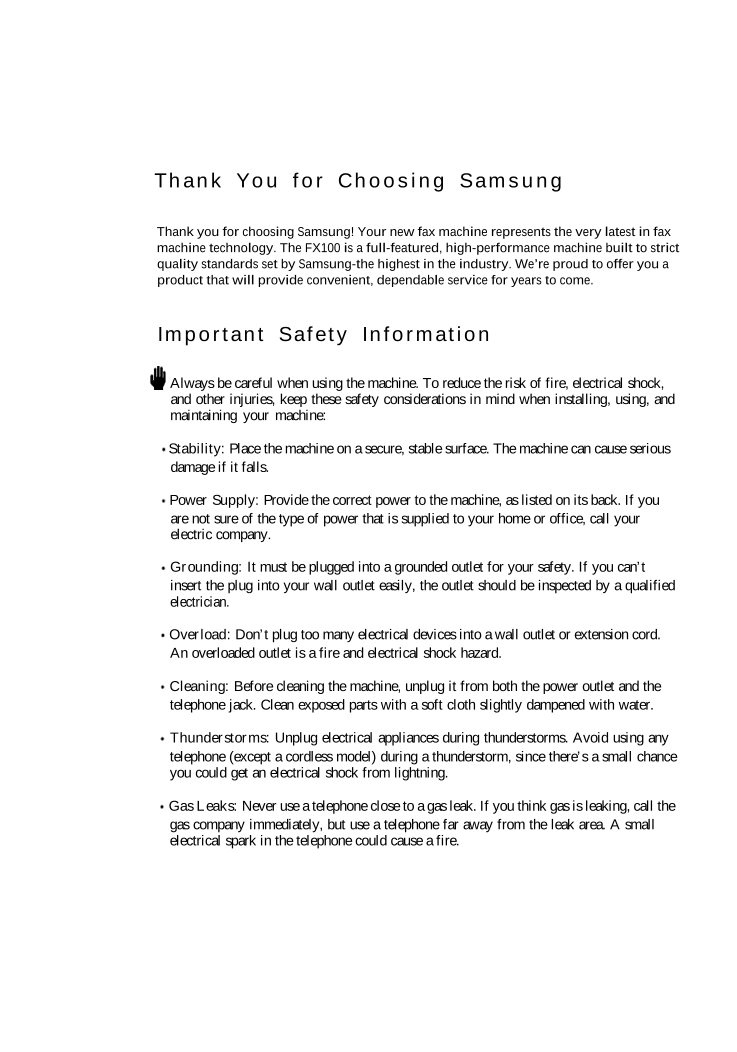
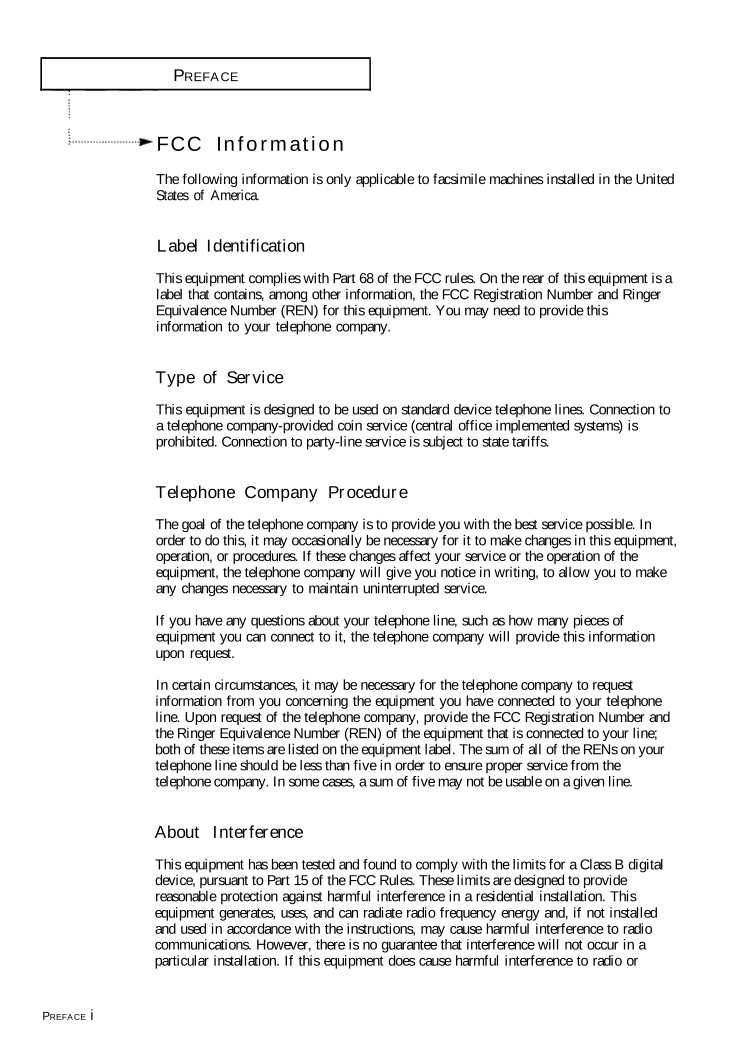
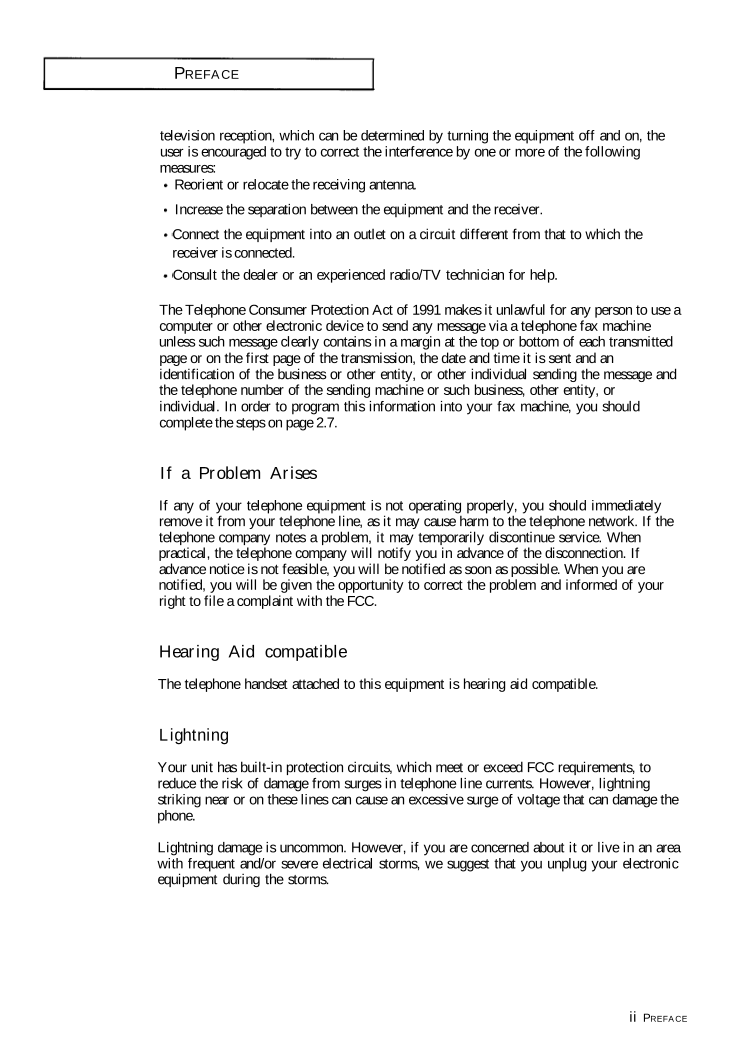

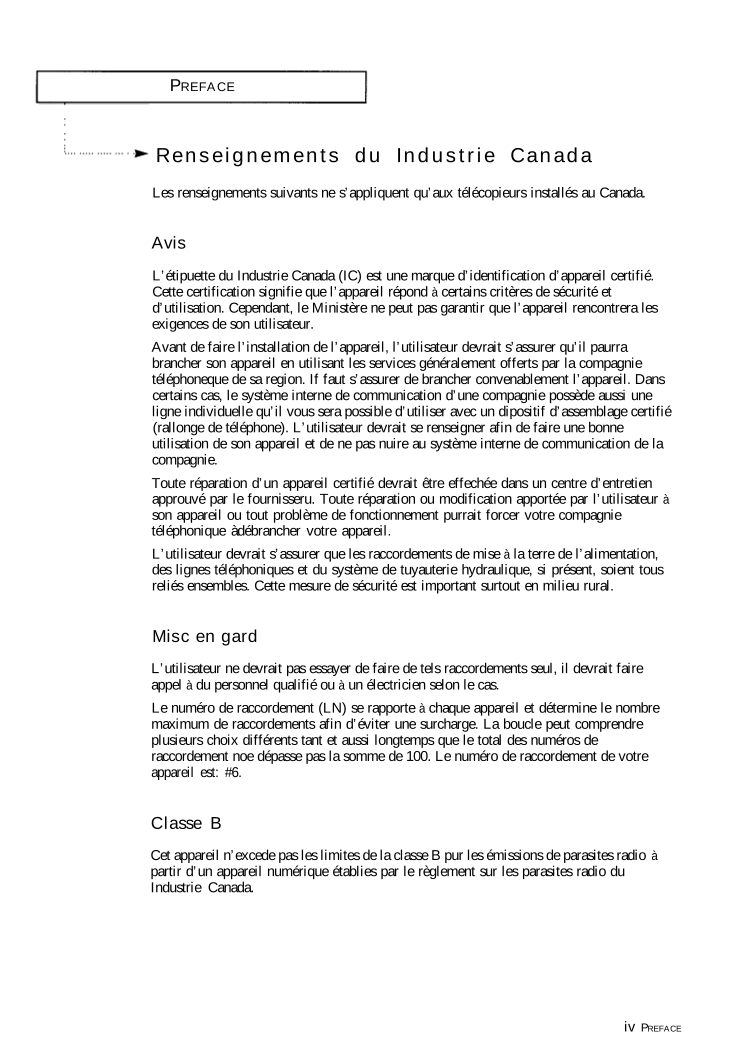
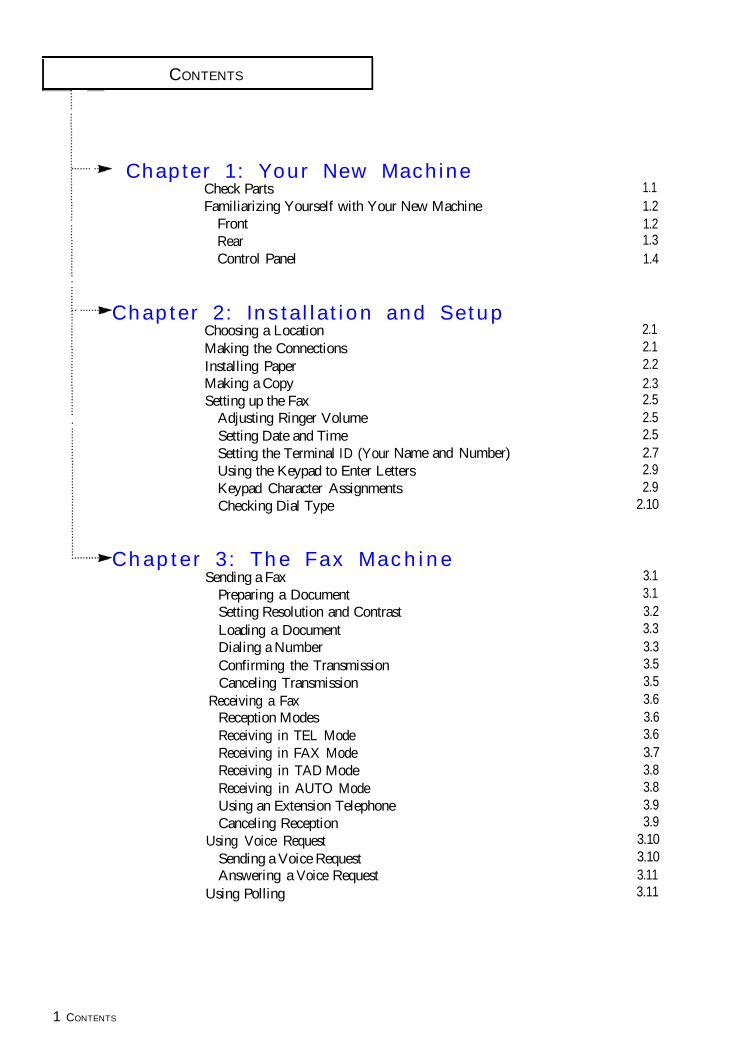








 2023年江西萍乡中考道德与法治真题及答案.doc
2023年江西萍乡中考道德与法治真题及答案.doc 2012年重庆南川中考生物真题及答案.doc
2012年重庆南川中考生物真题及答案.doc 2013年江西师范大学地理学综合及文艺理论基础考研真题.doc
2013年江西师范大学地理学综合及文艺理论基础考研真题.doc 2020年四川甘孜小升初语文真题及答案I卷.doc
2020年四川甘孜小升初语文真题及答案I卷.doc 2020年注册岩土工程师专业基础考试真题及答案.doc
2020年注册岩土工程师专业基础考试真题及答案.doc 2023-2024学年福建省厦门市九年级上学期数学月考试题及答案.doc
2023-2024学年福建省厦门市九年级上学期数学月考试题及答案.doc 2021-2022学年辽宁省沈阳市大东区九年级上学期语文期末试题及答案.doc
2021-2022学年辽宁省沈阳市大东区九年级上学期语文期末试题及答案.doc 2022-2023学年北京东城区初三第一学期物理期末试卷及答案.doc
2022-2023学年北京东城区初三第一学期物理期末试卷及答案.doc 2018上半年江西教师资格初中地理学科知识与教学能力真题及答案.doc
2018上半年江西教师资格初中地理学科知识与教学能力真题及答案.doc 2012年河北国家公务员申论考试真题及答案-省级.doc
2012年河北国家公务员申论考试真题及答案-省级.doc 2020-2021学年江苏省扬州市江都区邵樊片九年级上学期数学第一次质量检测试题及答案.doc
2020-2021学年江苏省扬州市江都区邵樊片九年级上学期数学第一次质量检测试题及答案.doc 2022下半年黑龙江教师资格证中学综合素质真题及答案.doc
2022下半年黑龙江教师资格证中学综合素质真题及答案.doc